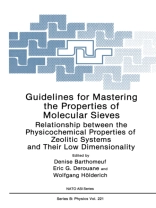Low dimensionality is a multifarious concept which applies to very diversified materials. Thus, examples of low-dimensional systems are structures with one or several layers, single lines or patterns of lines, and small clusters isolated or dispersed in solid systems. Such low- dimensional features can be produced in a wide variety of materials systems with a broad spectrum of scientific and practical interests. These features, in turn, induce specific properties and, particularly, specific transport properties. In the case of zeolites, low dimensionality appears in the network of small-diameter pores of molecular size, extending in one, two or three di- mensions, that these solids exhibit as a characteristic feature and which explains the term of "molecular sieves" currently used to name these ma- terials. Indeed, a large number of industrial processes for separation of gases and liquids, and for catalysis are based upon the use of this low- dimensional feature in zeolites. For instance, zeolites constitute the first class of catalysts employed allover the world. Because of the peculiarity and flexibility of their structure (and composition), zeolites can be adapted to suit many specific and diversified applications. For this reason, zeolites are presently the object of a large and fast-growing interest among chemists and chemical engineers.
Denise Barthomeuf & E.G. Derouane
Guidelines for Mastering the Properties of Molecular Sieves [PDF ebook]
Relationship between the Physicochemical Properties of Zeolitic Systems and Their Low Dimensionality
Guidelines for Mastering the Properties of Molecular Sieves [PDF ebook]
Relationship between the Physicochemical Properties of Zeolitic Systems and Their Low Dimensionality
购买此电子书可免费获赠一本!
语言 英语 ● 格式 PDF ● ISBN 9781468457872 ● 编辑 Denise Barthomeuf & E.G. Derouane ● 出版者 Springer US ● 发布时间 2013 ● 下载 3 时 ● 货币 EUR ● ID 4730901 ● 复制保护 Adobe DRM
需要具备DRM功能的电子书阅读器












